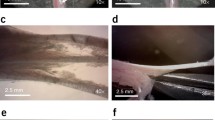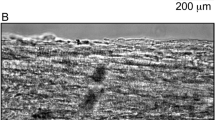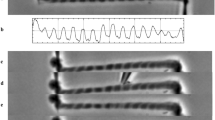Abstract
The structural changes of the Z-line between small square net (ss) and basket weave (bw) cross-sectional patterns were examined using intact single fibers and mechanically skinned fibers in the passive state to determine if the pattern is related to the sarcomere length (SL) and if the pattern undergoes a reversible transition in low- and high-osmotic medium.
Frog single fibers were isolated from the anterior tibial muscle in Ringer's solution. Entirely or partially skinned single fibers were prepared in relaxing solution (also called low-osmotic medium).The high osmotic medium contained 10% polyvinylpyrrolidone (PVP) in relaxing solution.
The sarcomere length (SL) of each fiber was measured directly by use of a laser beam or indirectly from electron micrographs with use of a correction factor. The ss and bw forms in cross sections were quantified by analysis of electron micrographs. The results show that the structural change of Z-line occurs around bw ≪ 2.3–2.4 μm ≪ ss (n = 25) and bw ≪ 3.1–3.2 μm ≪ ss (n = 13) in intact single fibers and skinned fibers, respectively. With the quick freeze-freeze substitution method, an intact single fiber with a SL of 2.35 μm showed almost 100% of ss form. The structural transition in cross section was also confirmed in four partially skinned fibers, where patterns went from mostly ss form (intact portion) to mostly bw form (skinned portion) at the SL between 2.40 to 3.20 μm.
The reversibility of the change between ss and bw was proved by using low- and high-osmotic medium. The transition and reversion of cross-sectional patterns both occur in the passive state.
Similar content being viewed by others
References
Bagni MA, Cecchi G, Griffiths PJ, Maeda Y, Rapp G and Ashley CC (1994). Lattice spacing changes accompanying isometric tension development in intact single muscle fibers. Biophys J 67: 1965-1975.
Edman KAP (1980) The role of non-uniform sarcomere behaviour during relaxation of striated muscle. Eur Heart J 1(Suppl. A): 49-57.
Edman KAP and Reggiani C (1987) The sarcomere length-tension relation determined in short segments of intact muscle fibers of the frog. J Physiol 385: 709-732.
Fürst DO, Osborn M, Nave R and Weber K (1988) The organization of titin filaments in the half-sarcomere revealed by monoclonal antibodies in immunoelectron microscopy: a map of ten nonrepetitive epitopes starting at the Z line extends close to the M line. J Cell Biol 106: 1563-1572.
Fürst DO, Nave R, Osborn M and Weber K (1989) Repetitive titin epitopes with a 42 nm spacing coincide in relative position with A-band striations also identified with major myosin-associated proteins. J Cell Sci 94: 119-125.
Gautel M, Goulding D, Bullard B, Weber K and Fürst DO (1996) The central Z-disk region of titin is assembled from a novel repeat in variable copy numbers. J Cell Sci 109: 2747-2754.
Goldman YE and Simmons RM (1986) The stiffness of frog skinned muscle fibres at altered lateral filament spacing. J Physiol 378: 175-194.
Goldstein MA, Michael LH, Schroeter JP and Sass RL (1986) The Z-band lattice in skeletal muscle before, during, and after tetanic contraction. J Musc Res Cell Motil 7: 527-536.
Goldstein MA, Michael LH, Schroeter JP and Sass RL (1987) Z band dynamics as a function of sarcomere length and the contractile state of muscle. FASEB J 1: 133-142.
Goldstein MA, Michael LH, Schroeter JP and Sass RL (1988) Structural states in the Z band of skeletal muscle correlate with states of active and passive tension. J Gen Physiol 92: 113-119.
Godt RE and Maughan DW (1977) Swelling of skinned muscle fibers of the frog. Experimental observations. Biophys J 19: 103-116.
Granger B and Lazarides E (1978) The existence of insoluble Z disc scaffold in chicken skeletal muscle. Cell 15: 1253-1268.
Gregorio CC, Trombitas K, Centner T, Kolmerer B, Stier G, Kunke K, Suzuki K, Obermayr F, Herrmann B, Granzier H, Sorimachi H and Labeit D (1998) The NH2 terminus of titin spans the Z-disc: its interaction with a novel 19-kD ligand (T-cap) is required for sarcomeric integrity. J Cell Biol 143: 1013-1027.
Gulati J and Badu A (1982) Tonicity effects on intact single muscle fibers: Relation between force and cell volume. Science 215: 1109-1112.
Heuser JE, Reese TS, Dennis MJ, Jan Y, Jan L and Evans L (1979) Synaptic vesicle exocytosis captured by quick freezing and correlated with quantal transmitter release. J Cell Biol 81: 275-300.
Jacobson C, Tirosh R, Delay MJ and Pollack GH (1983) Quantized nature of sarcomere shortening steps. J Musc Res Cell Motil 4: 529-542.
Jeng CJ and Wang SM (1992) Interaction between titin and a-actinin. Biomed Res 13: 197-202.
Keller TCS (1997) Molecular bungees. Nature 387: 233-235.
Knappeis GG and Carlsen F (1962) The ultrastructure of the Z-disc in skeletal muscle. J Cell Biol 13: 323-335.
Krasner B and Maughan D (1984) The relationship between ATP hydrolysis and active force in compressed and swollen skinned muscle fibers of the rabbit Pflügers Arch 400: 160-165.
Linke WA, Ivemeyer M, Olivieri N, Kolmerer B, Rüegg JC and Labeit S (1996) Towards a molecular understanding of the elasticity of titin. J Mol Biol 261: 62-71.
Maruyama K, Matsubara S, Natori R, Nonomura Y, Kimura S, Ohashi K, Murakami F, Handa S and Eguchi G (1977) Connectin, an elastic protein of muscle: Characterization and function. J Biochem 82: 317-337.
Maruyama K (1997) Connectin/titin, giant elastic protein of muscle. FASEB J 11: 341-345.
Maruyama K, Yoshioka T, Higuchi H, Ohashi K, Kimura S and Natori R (1985) Connectin filaments link thick filaments and Z lines in frog skeletal muscle as revealed by immunoelectron microscopy. J Cell Biol 101: 2167-2172.
Maruyama K, Matsuno A, Higuchi H, Shimaoka S, Kimura S and Shimizu T (1989) Behaviour of connectin (titin) and nebulin in skinned muscle fibers after extreme stretch as revealed by inimunoelectron microscopy. J Musc Res Cell Motil 10: 350-359.
Mayans O, van der Ven PFM, Wilm M, Mues A, Young P, Fürst DO, Wilmanns M and Gautel M (1998) Structural basis for activation of the titin kinase domian during myofibrillogenesis. Nature 395: 863-865.
Oba T and Yamaguchi M (1990) Sulfhydryls on frog skeletal muscle membrane participate in contraction. Am J Physiol 259: C709-C714.
Oba T and Hotta K (1983) The effect of changing free Ca2+ on light diffraction intensity and correlation with tension development in skinned fibers of frog skeletal muscle. Pflügers Arch 397: 243-247.
Oba T, Baskin RJ and Lieber RL (1981) Light diffraction studies of active muscle fibres as a function of sarcomere length. J Musc Res Cell Motil 2: 215-224.
Ohtsuka H, Yajima H, Murayama K and Kimura S (1997a) The N-terminal Z repeat 5 of connectin/titin binds to the C-terminal region of a-actinin. Biochem Biophys Res Commun 235: 1-3.
Ohtsuka H, Yajima H, Maruyama K and Kimura S (1997b) Binding of the N-terminal 63 kDa portion of connectin/titin to a-actinin as revealed by the yeast two-hybrid system. FEBS Lett 401: 65-67.
Peckham M, Young P and Gautel M (1997) Constitutive and variable regions of Z-disk titin/connectin in myofibril formation: a dominant-negative screen. Cell Struct Funct 22: 95-101.
Politou AS, Gautel M, Improta S, Vangelista L and Pastore A (1996) The elastic I-band region of titin is assembled in a ``Modular'' fashion by weakly interacting Ig-like domains. J Mol Biol 255: 604-616.
Sorimachi H, Freiburg A, Kolmerer B, Ishiura S, Stier G, Gregorio CC, Labeit D, Linke WA, Suzuki K and Labeit S (1997) Tissue-specific expression and a-actinin binding properties of the Z-disc titin: Implications for the nature of vertebrate Z-discs. J Mol Biol 270: 688-695.
Squire JM (1997) Architecture and function in the muscle sarcomere. Curr Opin Struct Biol 7: 247-257.
Tskhovrebova L, Trinick J, Sleep JA and Simmons RM (1997) Elasticity and binding of single molecules of the giant muscle protein titin. Nature 387: 308-312.
Turnacioglu KK, Mittal B, Dabiri GA, Sanger JM and Sanger JW (1997) An N-terminal fragment of titin coupled to green fluorescent protein localizes to the Z-bands in living muscle cells: overexpression leads to myofibril disassembly. Mol Biol Cell 8: 705-717.
Valle G, Faulkner G, De Antoni G, Pacchioni B, Pallavicini A, Pandolfo D, Tiso N, Toppo S, Trevisan S and Lanfranchi G (1997) Telethonin, a novel sarcomeric protein of heart and skeletal muscle. FEBS Lett 415: 163-168.
Wang K, McClure J and Tu A (1979) Titin: Major myofibrillar components of striated muscle. Proc Natl Acad Sci USA, 76: 3697-3702.
Wang K (1985) Sarcomere-associated cytoskeletal lattices in striated muscle. In: Shay J (ed) Cell and Muscle Motility. (vol. 6, pp. 315-369) Plenum Publ. Corp., New York.
Wang K and Wright J (1988) Architecture of the sarcomere matrix of skeletal muscle: immunoelectron microscopic evidence that suggests a set of parallel inextensible nebulin filaments anchored at the Z line. J Cell Biol 107: 2199-2212.
Wang K, Ramirez-Mitchell R and Palter D (1984) Titin is an extraordinarily long, flexible, and slender myofibrillar protein. Proc Natl Acad Sci USA 81: 3685-3689.
Yamaguchi M, Izumimoto M, Robson RM and Stromer MH (1985) Fine structure of wide and narrow vertebrate muscle Z-lines: a proposed model and computer simulation of Z-line architecture. J Mol Biol 184: 621-644.
Young P, Ferguson C, Banuelos S and Gautel M (1998) Molecular structure of the sarcomeric Z-disk: two types of titin interactions lead to an asymmetrical sorting of a-actinin. EMBO J 17: 1614-1624.
Author information
Authors and Affiliations
Rights and permissions
About this article
Cite this article
Yamaguchi, M., Fuller, G.A., Klomkleaw, W. et al. Z-line structural diversity in frog single muscle fiber in the passive state. J Muscle Res Cell Motil 20, 371–381 (1999). https://doi.org/10.1023/A:1005537500714
Issue Date:
DOI: https://doi.org/10.1023/A:1005537500714




